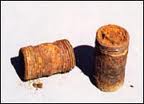 If you’ve ever been working on a water heater and one of the nipples won’t budge, you know it can cause panic. Generally, try some penetrating oil, get a larger wrench or use a cheater bar to extend the levering action. This may cause the nipple to snap off which will make anyone weak-kneed.
If you’ve ever been working on a water heater and one of the nipples won’t budge, you know it can cause panic. Generally, try some penetrating oil, get a larger wrench or use a cheater bar to extend the levering action. This may cause the nipple to snap off which will make anyone weak-kneed.
It may look bleak seeing the broken nipple lodged in the water heater, but there are ways to remove it. There are nipple extractors, but I like to use a combination of tools to remove the broken nipple.
Take a hacksaw blade out of the frame so that you are holding just the blade. It usually won’t cut you, but use it carefully anyway. Some heavy gloves will help grip it and protect your hands. You are going to place the blade into the middle of the nipple and cut from the inside of the nipple towards the threads on the outside of the nipple. You must take great care NOT to cut through the threads. The goal here is simply to weaken the wall of the nipple so that you can collapse it. Check your cut regularly to make sure you don’t hit the threads. Once you have cut to a depth you feel comfortable with, use a chisel and hammer and hit the edge of the nipple inward at the point where you made the cut. This is the weakest part of the nipple. As you tap on the nipple you will see it cave inward along the cut line. Continue this until you can grab the metal and twist it out, or just keep hitting the nipple along the perimeter of the opening until it is weak enough that you can pull it out.
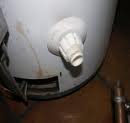 Your water heater may be leaking from the drain valve, or maybe you just flushed the tank and the valve won’t shut off. It’s time to replace the valve.
Your water heater may be leaking from the drain valve, or maybe you just flushed the tank and the valve won’t shut off. It’s time to replace the valve.
These valves are typically made of plastic and it’s no wonder they can’t be trusted to shut off the water when you need it. You can buy replacement drain valves for about $10.00.
You can choose to drain the water heater or not. Regardless, start by turning off the control valve (if gas) or turn off the power (if electric). If you choose to drain the tank, connect a hose to the valve and open the valve to drain the water. If you choose not to drain the tank, keep the water on to the tank and open a hot water faucet near the tank. When the water runs cool you can turn off the faucet, and close the water supply valve to the tank. Realize that you will be working quickly and will lose only a few cups of water from the tank. This all hinges upon nobody in the house turning the water on. So long a the water is off to the tank and nobody turns the water on inside the house (allowing air into the system), the water will not fully run out of the tank.
Use a wrench and unscrew the old drain valve. Have the new valve ready to screw back in after wrapping the threads with Teflon tape. Like I said, a few cups of water will drip out so long as nobody opens a faucet inside the house. Screw on the new valve until snug and turn the water back on, checking for leaks.
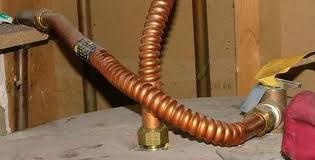 I see a lot of home inspections calling for a repair on the water heater TPR (temperature & pressure relief) drain line. The issue that the home inspector generally calls out is that the drain line is trapped, or has an uphill rise in it. This can be a dangerous situation because when the TPR valve opens it is either due to high pressure or high water temperatures. If the water and steam blowing from this valve finds resistance from the drain line, it may result in severe damage to the tank and anyone near it. For this reason the drain line cannot have any rise in it.
I see a lot of home inspections calling for a repair on the water heater TPR (temperature & pressure relief) drain line. The issue that the home inspector generally calls out is that the drain line is trapped, or has an uphill rise in it. This can be a dangerous situation because when the TPR valve opens it is either due to high pressure or high water temperatures. If the water and steam blowing from this valve finds resistance from the drain line, it may result in severe damage to the tank and anyone near it. For this reason the drain line cannot have any rise in it.
The biggest challenge is when the point where the drain line exits the tank is lower that the point where it enters the wall (in many cases the drain is run through the wall to the exterior of the house). This will mean you will have to either raise the tank (not likely), or lower the drain line in the wall. You will have to open the wall and lower the point where it meets the drain.
Sometimes it is an easy fix though. Many times the installer will use a long flexible copper line, and it is so long that he is forced to bend it every which way to get it to fit. If any of these bends reduce the size of the drain line, or cause it to have an uphill rise, it is a potentially dangerous situation. However, this can usually be repaired by turning the flexible copper line in such a way so that there is no rise in the line.
 The water heater TPR valve (temperature & pressure relief valve) is a critical safety component of your water heater. It helps prevent explosions from excessive pressure and heat inside the tank.
The water heater TPR valve (temperature & pressure relief valve) is a critical safety component of your water heater. It helps prevent explosions from excessive pressure and heat inside the tank.
The TPR valve opens when the water temperature exceeds 150-degrees or the pressure exceeds 210 psi to relieve dangerous conditions inside the tank. The valve is piped away from the tank and carries away the hot water and steam.
If the TPR drain is discharging water, people automatically assume that it is broken. That's not always the case. It may be operating correctly and relieving the water heater tank of dangerous termperatures or excessive pressure.
The valve may need replaced, but try a few things first. Go into the house and run some hot water out of a faucet. This will allow hot water to exit the tank and allow cold incoming water to enter the tank. Also, turn the temperature on the thermostat down. The combination of these two items should alleviate the temperature issue.
If you were testing the TPR valve by lifting the tab on it and now it won't shut off, you can try lightly tapping it with a hammer. Sometimes this works and sometimes not.
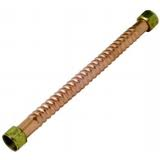 Many people wonder if they need to replace the copper flex lines when installing a new water heater. My answer is probably not. As long as the copper flex lines are not damaged or corroded in some way, they should last for decades. Notice I said as long as they are not damaged or corroded. I have seen people twist these lines in an unnatural way that causes them to bend or kink. This is a problem because it can minimize the volume of water flowing through the pipes.
Many people wonder if they need to replace the copper flex lines when installing a new water heater. My answer is probably not. As long as the copper flex lines are not damaged or corroded in some way, they should last for decades. Notice I said as long as they are not damaged or corroded. I have seen people twist these lines in an unnatural way that causes them to bend or kink. This is a problem because it can minimize the volume of water flowing through the pipes.
In the case of a temperature and pressure relief valve (TPR), minimizing the volume when the valve opens due to excessive heat or pressure can cause catastrophic damage (the tank could explode). So it is important that the copper flex lines have only gradual changes of direction.
So you likely won’t need to replace the water supply lines, but you should replace the washers inside the fittings at the end of these lines. They are inexpensive and will replace the nasty squashed washers that have sat in there for years. Dig out the old washer and simply push the new one into the fitting until it bottoms out against the back of the fitting. Then install the flex line to the water heater’s nipples.
 If you have an electric water heater and it has stopped producing hot water, there are many things that could be the problem. Before you start leafing through the yellow pages for a plumber, try this quick fix first.
If you have an electric water heater and it has stopped producing hot water, there are many things that could be the problem. Before you start leafing through the yellow pages for a plumber, try this quick fix first.
Electric water heaters have 2 heating elements, one in the upper part of the tank and one in the lower part of the tank. Sometimes these heating elements will stop working and need to be replaced.
In addition to the heating elements, there are thermostats that tell the elements to turn on and off to heat the water to the desired temperature. If the system gets overloaded, it will shut off and stop heating water. This situation might be a one-time problem, or it may be indicative of a larger underlying problem. The first thing to do is to push the reset button.
These are under a metal coverings on the outside wall of the tank. Remove the covers and you may need to push away some insulation to get to the reset button. When you press the button you should feel a little resistance and maybe even hear it “click” and it restarts. If all goes well, you should have hot water in about an hour.
 If your gas water heater was manufactured after 2003, the chances are good that it has a FVIR (Flammable Vapor Ignition Resistance) feature. These are water heaters with a flame arrestor and filter screen that increase the safety of the unit. They have a sealed burner that differs from the older water heaters. FVIR water heaters have an ignitor button to light the pilot, whereas the older style allowed you to light a match and place it into the burner assembly to manually light the pilot.
If your gas water heater was manufactured after 2003, the chances are good that it has a FVIR (Flammable Vapor Ignition Resistance) feature. These are water heaters with a flame arrestor and filter screen that increase the safety of the unit. They have a sealed burner that differs from the older water heaters. FVIR water heaters have an ignitor button to light the pilot, whereas the older style allowed you to light a match and place it into the burner assembly to manually light the pilot.
Water heater pilots sometimes go out. Instructions for re-lighting them are posted on the side of the tank, but if the pilot continues to go out, you need to do some troubleshooting.
You may end up replacing the burner assembly or even the gas control, but cleaning the filter might just do the trick. You will need a long wire brush (preferably with plastic bristles), and a vacuum cleaner with an upholstery attachment (the long skinny one). Turn the water heater off and let it cool down for 15 minutes or so.
At the very bottom of the water heater will be an opening or two about an inch tall. These openings are covered by a screen. Remove this screen and vacuum it or wash it with soap and water. Removing this screen will give you access to the filter. The filter is located on the underside of the burner area. If this filter is clogged with lint or dirt, it will prohibit air from entering the burner chamber and consequently the burner won’t be able to heat the water. You may find that there is enough air passing to allow the pilot to stay lit, but when the demand increases to fire the burner, it will go out.
Stick the wire brush into the opening and rub the underside of the burner chamber at the center of the water heater. Rub it a few times and pull it out to inspect. You will probably see lint and dust that the brush has picked up. Vacuum this off of the brush and stick it back into the opening. Repeat this several times until the brush comes out clean and then vacuum the entire area including the area under the burner chamber. Replace the screen and follow the directions on re-lighting the pilot.
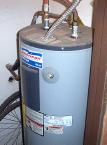 A water heater leak can be terrible. They put a halt to the household’s normal business and cause secondary damage to the surrounding area. When the tank leaks you have to replace it. When you replace the water heater tank, it’s a good idea to invest an extra 50 cents on new washers.
A water heater leak can be terrible. They put a halt to the household’s normal business and cause secondary damage to the surrounding area. When the tank leaks you have to replace it. When you replace the water heater tank, it’s a good idea to invest an extra 50 cents on new washers.
If you screw the copper flex lines right back down on new nipples, you may not have a problem, but why risk it? The copper flex lines should last for a very long time, but the washers that go between them and the nipples get squished and distorted. In a pinch I have pulled them out and flipped them over for a fresh surface, but really you can’t do better than new washers.
You will probably have trouble digging them out of the nut at the end of the copper flex lines. Stick your finger in there and pry them away from the female end of the line. Simply press the new washer into the line so that it butts up against the bottom of the female fitting. Do this for both the hot and cold lines. You will also find, as a side benefit, that the flex lines will screw on to the nipples much smoother and easier.
 The moment comes when you have to turn off the water to your water heater. You get a ladder to turn off the knob at the top of the water heater and it keeps turning...and turning. Over the years, the valve has corroded and won't turn the water off.
The moment comes when you have to turn off the water to your water heater. You get a ladder to turn off the knob at the top of the water heater and it keeps turning...and turning. Over the years, the valve has corroded and won't turn the water off.
Your choices at this point are to turn off the water at the main shut-off valve in the street (here's how to turn the water off at the street), or you may have another shut-off valve at a different location, such as your garage.
At some point you will need to replace the faulty valve at the top of your water heater. You probably have a gate valve (it's about $2 cheaper than a superior ball valve and that's why the builder installed it), but it is far better to install a ball valve. Here is a discussion on a ball valves vs. gate valves. They both will install in the same manner but the ball valve is far more dependable in a time of crisis.
You will need to break out the torch and sweat the new valve on to the water supply line. Here are details on how to solder copper. Once you have the new valve installed you can turn on the water at the street to test for leaks, and the next time you need to service the water heater, this new valve will isolate it from the rest of the house water supply. That means you can flush the toilets to your heart's content while the water to the water heater is off.
 Sometimes your water heater is just looking for a little attention. After you drain your water heater, there are times that the drain valve won't shut off, or maybe it just decides to start leaking all on its own. Either way, it means you get to perform a little service work.
Sometimes your water heater is just looking for a little attention. After you drain your water heater, there are times that the drain valve won't shut off, or maybe it just decides to start leaking all on its own. Either way, it means you get to perform a little service work.
The valve to drain the tank is located at the front of the water heater near the bottom of the tank. Some people call it a drain valve, hose bib, hose faucet, drain cock, etc. They all are a means to drain the tank.
These valves are all usually plastic and are fairly easy to install. You must turn off the water entering the tank. You can do this by the shut-off valve at the top of the tank, or you can turn off the water to the house. It's not necessary to drain the tank to do this repair, but when you open the drain valve you will get a few cups of water that spill out. Think about this: if you have a straw in a glass of water and you put your finger over the end of the straw and pull it out of the glass, the water stays in the straw right? Well it's the same for your water heater, as long as nobody in the house opens a hot water faucet you will be fine. However, if someone does open a faucet and allows air into the hot water line, you will get plenty of hot water running out of the drain valve...just like if you remove your finger off of the straw.
Replacing the valve is a matter of unscrewing the old one off and twisting a new valve back on. Just wrap the new valve's threads with several wraps of Teflon tape to seal out any leaks.